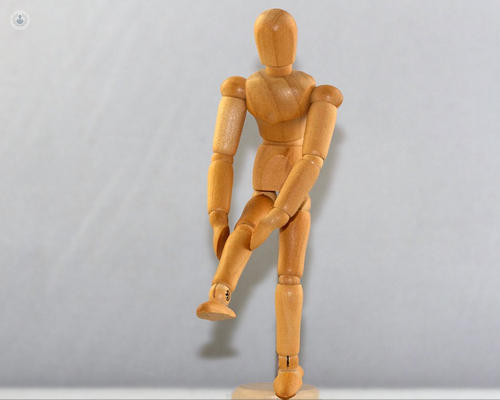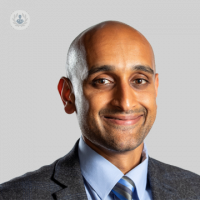Knee pain: a complete guide to understanding prevention and causes
Written by:Knee problems are a common issue that affects all ages. Everyone from the young and fittest athletes, to elderly patients, can suffer from knee complaints. As well as being a highly experienced London-based Consultant Trauma and Orthopaedic surgeon, Mr Akash Patel is a keen runner with a family history of knee trouble. Speaking from a professional and personal level, the surgeon shares his tips on the prevention and management of knee pain.

What are the first signs of knee problems?
The most common symptoms include pain, stiffness, swelling, catching, clicking, locking, and giving way. Other symptoms include redness, warmth, and popping or crunching sounds.
The knee is a complex joint, which consists of bone, tendons, ligaments, muscles, and cartilage. The joint is made up of the femur (thigh bone), tibia (shin bone), and patella (knee cap). Each one of these can potentially generate symptoms. Knee problems often result from injury, wear-and-tear, infection, or inflammation. Knee pain can also be caused by hip and back problems.
How can knee pain be prevented?
It may not always be possible to prevent knee problems, but the following suggestions may reduce the risk of joint deterioration and knee injuries:
- Weight management: Keep the extra pounds off! Maintaining a healthy weight is one of the best things you can do for your knees. Every additional pound of weight puts extra strain on your joints. This increases the risk of osteoarthritis and knee injuries.
- Muscle strengthening: Your knee is a complex joint made up of bone, cartilage, muscle, tendon, and ligaments. Strong muscles help to support the joint and reduce the risk of problems with other components. Weak muscles are one of the leading causes of injury. Build up your hamstrings and quadriceps, the muscles on the back and front of your thigh.
- Flexibility: Regular stretching helps prevent knee injury. Tight muscles, tendons, and ligaments are at higher risk of injury and damage. Try to incorporate daily flexibility exercises into your workouts.
- Balance: Stability training helps the muscles around your knee work together more effectively. Build this into your routine. Even simple things like trying to balance one leg will help improve this. One of the functions of ligaments is to support the balancing of your knee. Good balance reduces the risk of ligament problems.
- Sports conditioning: Sport-specific training is one of the best ways to reduce the risk of knee injuries. Prepare your body for the demands of sport participation. Practise plenty and get in shape before you play or undertake any competition.
- Listen to your body: Be smart about exercise. You will have “good” pain and “bad” pain, which you will know and feel during training. Over-training can lead to worse knee and muscle problems. Take breaks and rest up. Let your body recover. “No pain, no gain” may not always be the correct way.
- Activity modification: If you have recurring injuries, osteoarthritis, or chronic knee pain, you may have to change the way you do things. Lower-impact activities, such as swimming and cycling may help. You may have to slow down on higher impact and high-intensity activity to reduce your pain and risk of further injury.
- Footwear: Sensible shoes and arch support, if required for flat feet, can help to reduce the risk of knee pain and injuries.
- Nutrition: Good quality food and fluids are imperative to overall health and knee performance. Optimising muscle and bone health involves balancing protein, vitamin D, calcium, carbohydrate, fat, and water intake. This is key to the prevention of knee problems and recovery from exercise.
What can cause knee pain?
Injuries: These can occur to any anatomical component of the knee joint, and can be sprains, partial tears, or complete tears or breaks. These include the menisci (shock absorbers), ligaments (most commonly the anterior cruciate ligament), bones, and tendons.
Arthritis: There are many different types of arthritis, which include osteoarthritis (joint degeneration which can occur following injury, underlying cartilage issues, or “wear and tear” due to aging) or inflammatory (such as rheumatoid, gout, pseudogout, or infection).
Knee cap problems: This can be due to abnormal anatomy, which contributes to dislocations or injury. Patellofemoral pain syndrome is a general term associated with pain in the front of the knee. It is common in athletes, young adults where the kneecap does not move properly in the groove, or older adults, who develop the condition as a result of knee cap arthritis.
Tendonitis or tendinopathy/ bursitis: These are conditions that may involve a component of inflammation in various tendons, such as the patella tendon, or areas around the knee, such as the front of the knee (prepatellar/infrapatellar bursitis) or side of the knee (iliotibial band friction syndrome).
Hip/ spine: Pain in the knee can be “referred” from different areas, such as the hip and spine. This means that even if the pain is in the knee, the problem may be in the hip joint or spine.
Cysts: These are fluid-filled sacs. They can occur due to a meniscal (“shock absorber”) problem inside the joint (injury or degeneration) or at the back of the knee (“Baker's cyst” associated with osteoarthritis).
What tests are done to diagnose knee pain?
The most common investigations we undertake for knee problems are imaging. This includes X-rays and scans. The scans include MRI, ultrasound, and/or CT. Occasionally, we may request blood tests and in very rare cases require knee samples (aspiration) to help with diagnosis.
How is knee pain treated?
Treatments include both non-operative and operative options depending on the diagnosis, which is key in determining the best solution for your knee. Non-operative measures include painkillers, physiotherapy, activity modification, lifestyle changes, heat or ice packs, knee braces, and injections.
Most patients do not require surgery and knee pain usually responds to conservative treatment. The most common surgical options include arthroscopy (keyhole surgery), specific ligament, cartilage, or knee cap procedures, and, usually end-stage, knee replacement.
When should I see a doctor about knee pain?
You should book a consultation with your doctor if:
- you cannot bear weight on your knee or if your knee gives way
- the knee locks and painfully clicks
- the knee is swollen and does not improve
- you struggle to bend or straighten the knee completely
- you have an obvious significant deformity in your knee or leg
- you have a fever, redness, pain, and associated swelling
- you have severe pain associated with injury
If you are suffering from knee pain and would like to book a consultation with Mr Akash Patel, a Consultant Trauma and Orthopaedic Surgeon in London, visit his Top Doctor’s profile today and book directly from his profile.


